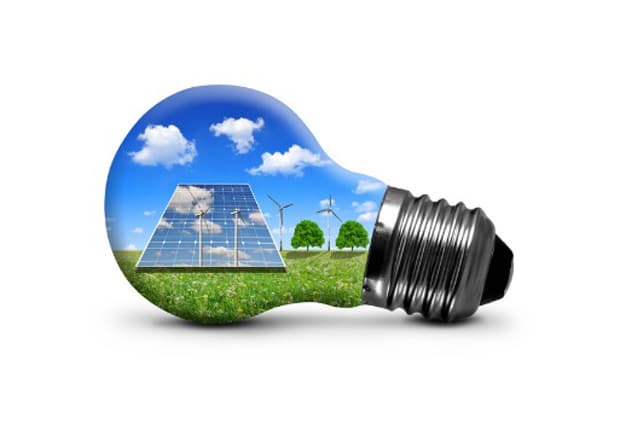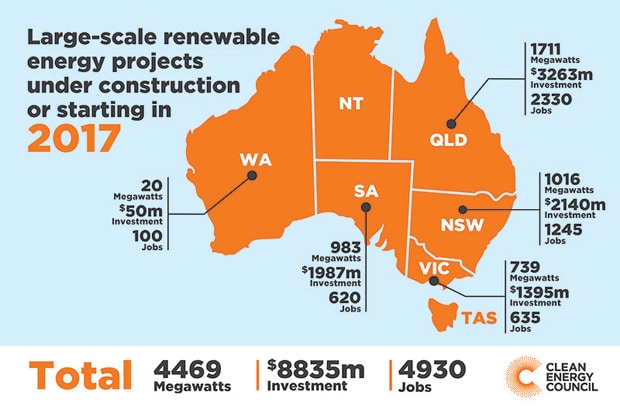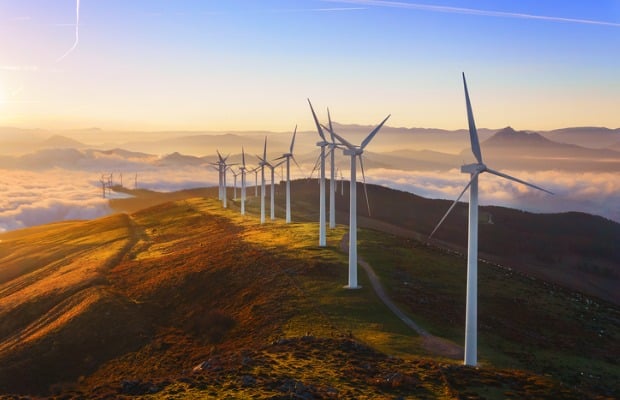Australians are facing a choice about where their electricity comes from, a choice that could see many of us become almost independent of retailers when it comes to home electricity use. The choice is between fossil-fuel electricity generation, and power from environmental sources, also known as renewable energy. Energy Matters knows that many people are keen to learn more, and to that end, we present our renewable energy FAQ.
In the financial year 2016-17, the National Electricity Market (NEM) traded $16.6 billion of energy. According to the Australian Competition and Consumer Commission (ACCC), retail customers in the National Electricity Market (which excludes Western Australia and the NT) now pay 44% more in real terms for electricity than they did ten years ago.
The production and distribution of electricity in Australia involves electricity power stations, transmission lines, coal, oil and gas production facilities, pipelines, refineries, wind and solar farms. All of these make up Australia’s energy mix.

Currently, Australians are dependent on fossil-fuels, which are non-renewable energy sources. Electricity generation from these sources (coal, natural gas, petroleum products) comprised 88% of the total electricity produced by Australian businesses in 2014–15.
The production and use of energy from these sources comes with a major environmental challenge. Energy is the largest single contributor to global emissions of greenhouse gases. Transport emissions are a significant source of urban air pollution, making up 18% of greenhouse gas emissions, according to Climate Council figures.
Energy projects affect Australia’s air and water quality, biodiversity, noise levels and heritage. Renewable energy meets these challenges because it produces few if any environmental effects and is in harmony with nature. To find out more, see our Renewable energy FAQ below.
Renewable energy FAQ
What is Renewable Energy?
Renewable energy is energy that is continuously replenished in the environment. Once coal and oil leave the earth that resource does not regenerate. It is non-renewable energy, also known as fossil-fuel energy because of its origins hundreds of millions of years ago as debris left from plant and animal remains.
But certain sources of energy are renewable because they are the result of continuous natural phenomenon, like the sun and the wind, a river flow, or the tide. Renewable energy comes from sources that are essentially inexhaustible.
But coal still dominates in electricity production. According to statistics from the Office of the Chief Economist, 32 per cent of our energy consumption in 2014-15 came from coal.
Renewable energy on the rise
However, figures from the Clean Energy Council show renewable energy provided 17.3 per cent of Australia’s electricity in 2016. This was a significant improvement compared to the previous year, when renewable energy provided 14.6 per cent of Australia’s electricity.
Solar energy is experiencing the biggest growth among renewable energy sources, with almost 60 per cent average annual growth over the last ten years.
Clean Energy Council figures show an $8.8 billion investment in large-scale renewable energy projects in 2017. Solar and wind projects were roughly equal, with Queensland leading the way on solar and Victoria and SA accounting for most of the wind power.

Renewable energy is an essential part of Australia’s low emissions energy mix and is important to Australia’s energy security. It plays a strong role in reducing Australia’s greenhouse gas emissions and helping Australia stay on track to meet its commitment to lowering CO2 emissions known as the Paris Agreement.
Australian Government support for renewable energy is currently in the form of a Renewable Energy Target, which is set to expire in 2020. The benefits of this support, however, will be felt for many years after the scheme ends.
How does renewable energy work?
Solar energy is the most practical form for households and small businesses – all it requires is a roof! Sunlight can be converted into electricity using photovoltaic (solar electric) panels. This electricity is also used to operate a multitude of electrical appliances.
When sunlight hits the cell, it produces a reaction in the special materials inside the cell. This reaction causes electrons to flow, which is the basis of electricity.
The sun’s energy also converts directly into heat using solar thermal (heating) panels to heat water. It can even create electricity through steam when conducted on a very large scale. Wind and flowing water can also generate electricity via turbines.

The sea can be an energy source by placing a turbine in a position where the tide turns it. There are also wave generators that use the motion of waves to compress air, which then drives turbines to create electricity.
Why is renewable energy important?
Energy is a basic input into virtually every aspect of personal and business activity. Energy, in some form, contributes to most household activities. For example, heating, cooling, cooking, lighting, transport or enjoying services or products that require energy in their supply.
Businesses also use energy in virtually all of their activities, whether it is processing and manufacturing materials, transporting goods, heating and cooling premises, providing telecommunication services or powering computers.
As a result, energy is a fundamental part of life in Australia and the energy sector is an essential component of the Australian Economy.
What are the benefits of using renewable energy?
One of the greatest benefits of renewable energy is its potential to provide affordable and clean sources of electricity. Additionally, savings increase through resource savings, increased revenue through eco-efficiencies, and reduced risks and finance costs.
Renewable energy also minimises pollution and positively impacts the environment in many ways. Companies who choose to use renewable energy enhance their reputations as socially responsible corporate citizens. This attracts today’s environmentally conscious consumers.
Essential benefits of renewable energy:
- Renewables are sustainable energy resources which means that they avoid the depletion of natural resources for future generations.
- Renewables avoid and reduce nitrogen oxide emissions, sulfur oxide emissions as well as carbon dioxide emissions.
- Improves air quality and visibility due to decreased burning of fossil fuels which avoids compliance costs.
- Renewable energy provides a new avenue for rural economic development.
- Renewable energy generation projects create vibrant new industries in local communities, frequently in rural areas.
If you have any questions that are not covered in our renewable energy FAQ, then please don’t hesitate to contact us.







































